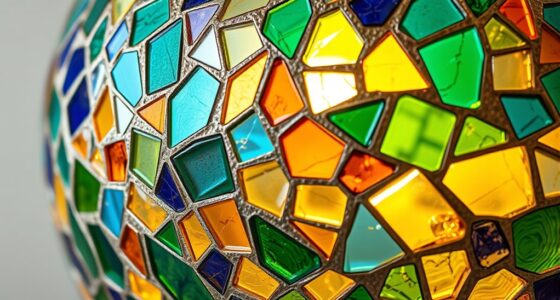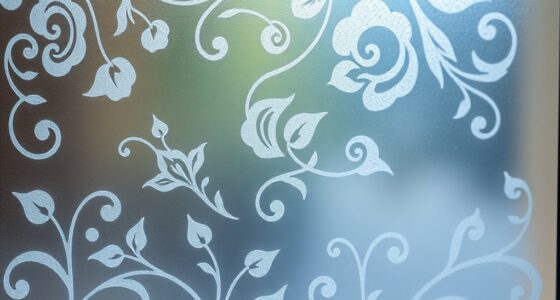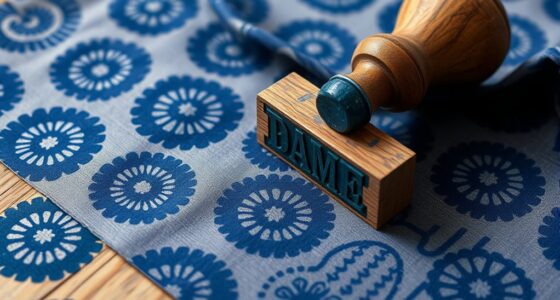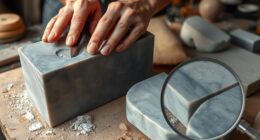To create beautiful decor journals, explore simple techniques like saddle stitch for quick binding, or try Coptic stitching for an artistic touch with exposed spines. Japanese stab binding adds elegant covers, while pamphlet stitching offers flexibility for personalized pages. Hidden spine binding gives a sleek, professional look. Additionally, experimenting with decorative papers, textured surfaces, and precise folding elevates your journal’s style. Keep going to discover detailed tips to perfect each method and craft stunning, unique books.
Key Takeaways
- Choose decorative papers and textured materials to personalize and enhance the visual appeal of your journal.
- Utilize simple binding techniques like saddle stitch or pamphlet stitch for quick, flexible projects.
- Incorporate embellishments such as fabric strips, decorative threads, or embossing to add artistic flair.
- Ensure precise folding, alignment, and neat stitching to achieve a professional, polished look.
- Reinforce binding with high-quality materials and hide components for a clean, durable finish.
Simple Saddle Stitch Binding
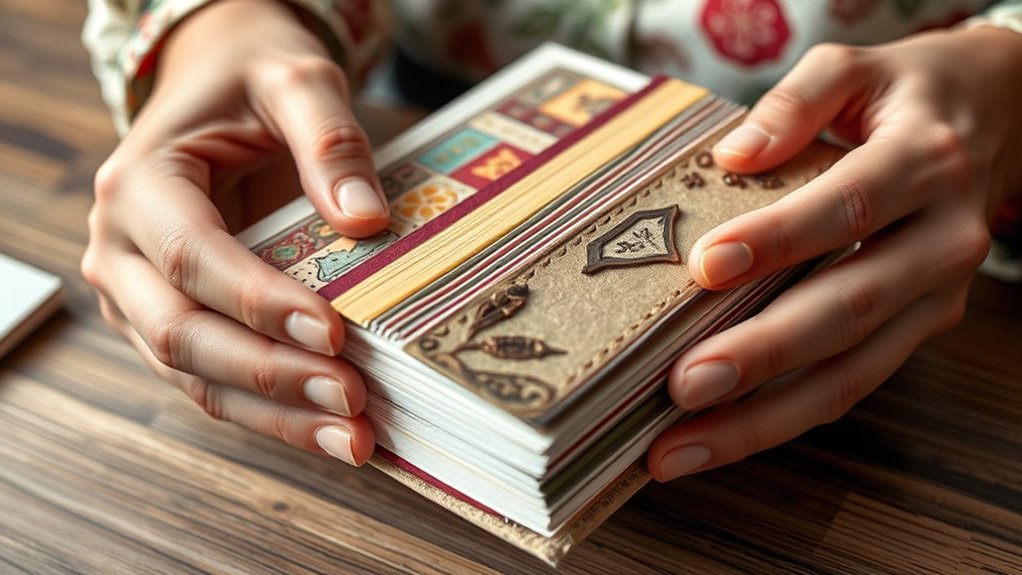
Simple saddle stitch binding is one of the easiest ways to assemble a small booklet or zine. You’ll start by selecting your paper, paying attention to its texture—smooth, matte, or textured—to give your project a unique feel. The paper texture influences how professional or handmade your final product appears. When choosing cover materials, consider sturdiness; cardstock or heavy paper works best to hold everything together. You can customize your cover’s appearance with colors, patterns, or even fabric overlays. To bind, simply fold your pages in half, align them neatly, and staple along the fold line. This method is quick, cost-effective, and perfect for short-run projects or personal journals. Your choice of paper texture and cover materials will set the tone for your finished booklet. Additionally, understanding different bookbinding techniques can help you refine your craft and create more durable or elaborate projects.
Coptic Stitch Binding for Artistic Flair

Building on basic saddle stitch techniques, Coptic stitch binding offers an artistic alternative that showcases craftsmanship and creativity. This method leaves the spine exposed, allowing you to add textile embellishments like fabric strips or decorative threads for a unique touch. You can also experiment with color blocking by choosing contrasting or complementary thread colors, creating visual interest along the stitched spine. The open structure makes it easy to incorporate embellishments directly into the binding, giving your journal a personalized, textured look. Coptic binding not only enhances the aesthetic appeal but also provides flexibility and durability. It’s perfect if you want a decorative, artisan feel that highlights your artistic flair, making your decor journal truly one-of-a-kind.
Japanese Stab Binding for Elegant Covers
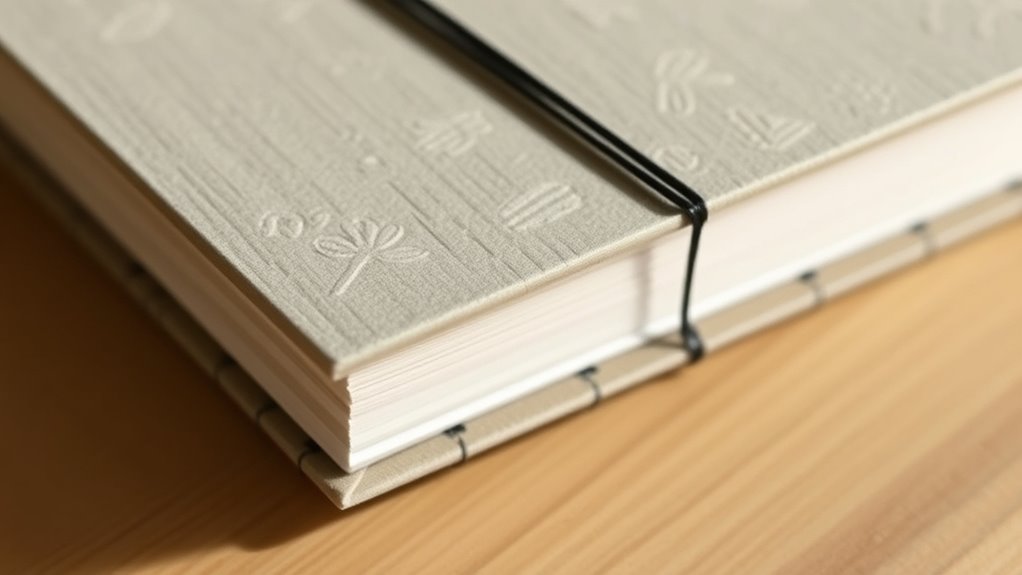
Japanese stab binding offers an elegant and versatile way to assemble your covers and pages, emphasizing clean lines and decorative stitching. This technique allows you to create a sleek, professional look perfect for decor journals. To enhance your design, consider adding calligraphy embellishments along the spine or cover, giving your journal a personalized touch. Cover embossing can also elevate the aesthetic, adding texture and sophistication. When binding, make certain your holes are evenly spaced and aligned for a neat appearance. You can experiment with different thread colors or patterns to match your style. Japanese stab binding is simple yet striking, making it ideal for showcasing your artistic accents and creating a refined, handcrafted journal. Additionally, understanding WWE Raw’s Financial Impact can inspire you to craft journals that reflect bold, dynamic designs, emphasizing the importance of presentation and storytelling.
Pamphlet Stitch for Flexible Journals

The pamphlet stitch is a classic binding method perfect for creating flexible, lightweight journals and booklets. To start, fold your paper in half to create signatures, which form the pages. Use decorative covers to add a personalized touch; you can choose textured or patterned paper to make your journal stand out. Mark evenly spaced holes along the fold line, ensuring they’re aligned across all signatures. Thread a needle with strong, contrasting thread and stitch through the holes, binding the signatures together. Keep the stitches tight but even for durability. This technique results in a flexible journal that’s easy to open and lay flat. The simplicity of folding paper and using decorative covers makes the pamphlet stitch ideal for quick, personalized projects. Additionally, choosing high-quality thread can improve the durability and overall appearance of your journal.
Hidden Spine Binding for a Clean Look
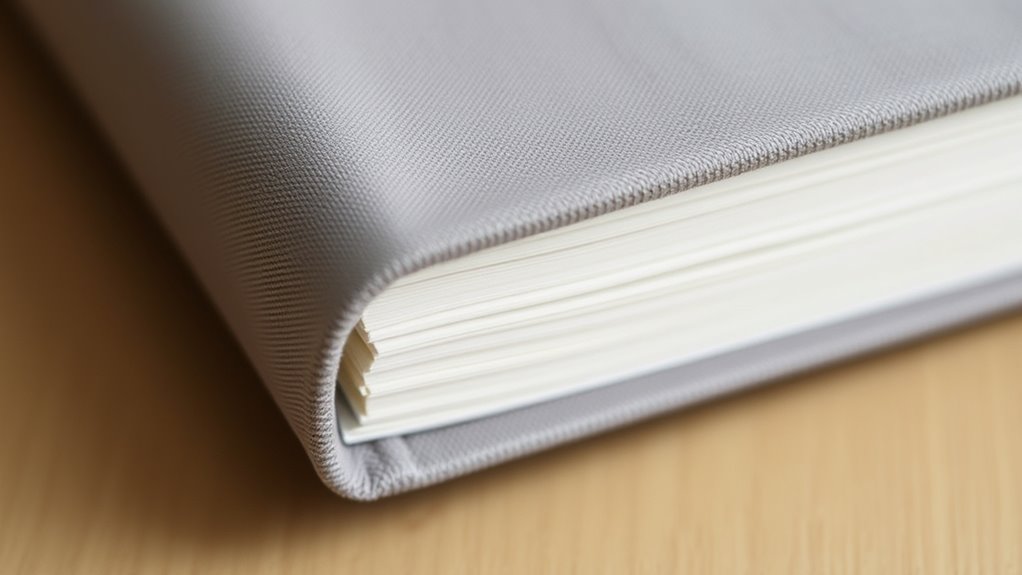
Hidden spine binding creates a seamless integration between the pages and cover, giving your book a polished look. By using concealed binding techniques, you can achieve a clean, professional finish without visible stitches or glue. This method not only enhances the aesthetic appeal but also strengthens the overall structure of your book. Incorporating secure binding methods ensures your journal remains durable and well-crafted over time.
Seamless Spine Integration
Creating a seamless spine in your bookbinding projects involves cleverly hiding the binding elements to achieve a clean, professional appearance. To do this, focus on integrating the spine so that the binding isn’t visible, enhancing the overall binding aesthetics. Start by selecting paper textures that complement each other, ensuring the cover and pages blend smoothly. Use a strong adhesive to attach the signatures securely while maintaining the spine’s smoothness. Consider reinforcing the spine with a fabric or bookbinding tape underneath the cover material for added durability. When done carefully, this technique results in a sleek, minimalist look that emphasizes the journal’s craftsmanship. The key is precise alignment and careful hiding of the binding components, creating a polished finish that looks effortless and refined. Additionally, paying attention to color consistency helps ensure that the entire journal appears cohesive and professionally finished.
Concealed Binding Techniques
Concealed binding techniques offer a sleek, professional appearance by hiding the spine and binding elements from view. To achieve this clean look, focus on binding material choices that are sturdy yet discreet, such as thin bookbinding glue or flexible linen threads. These materials allow you to secure pages firmly without creating visible stitches or hardware. When constructing the binding, you can conceal the spine inside a decorative cover design, like a wraparound cover or a slipcase, which hides any binding mechanics. This approach emphasizes the aesthetics of your journal, making it appear seamless and polished. The key is to carefully hide all binding components within the cover, so the finished product looks refined, with no visible signs of the binding process. Utilizing appropriate binding techniques ensures durability while maintaining the sleek, hidden appearance.
Elegant Aesthetic Appeal
Achieving an elegant, clean look in your bookbinding projects starts with choosing the right techniques to hide the spine. Using a hidden spine binding method creates a seamless appearance, perfect for showcasing vintage typefaces on your covers. To elevate the aesthetic, consider embossing covers with intricate patterns or lettering, adding texture and sophistication. When combined with a concealed spine, embossed covers draw attention to design details while maintaining a sleek, minimalist profile. This approach is ideal for decor journals, giving them a polished, professional feel. The absence of visible staples or stitches allows vintage fonts and embossed elements to stand out, creating a refined, timeless appeal. Incorporating affiliate products like specialty binding materials can also enhance the overall craftsmanship of your project. With these techniques, your journal will exude elegance and craftsmanship, enthralling anyone who sees it.
Accordion Fold Journals With a Unique Touch
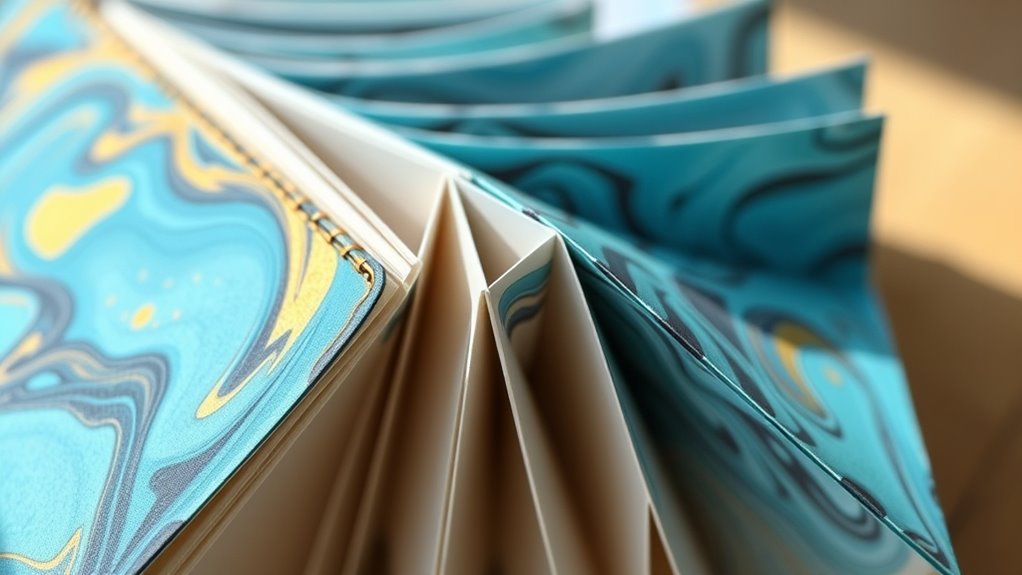
Choosing the right decorative paper can instantly make your accordion fold journal stand out. Mastering seamless fold techniques guarantees clean, professional-looking pages. With these tips, you’ll add a truly unique touch to your handmade journal. Incorporating high-quality materials can enhance the durability and appearance of your finished project.
Decorative Paper Selection
Have you ever considered how the right decorative paper can transform an ordinary accordion fold journal into a truly unique piece? Choosing the right paper enhances its visual appeal and tactile experience. Opt for printable patterns that match your style, whether floral, geometric, or abstract. Textured surfaces add depth and interest, making each page feel special. When selecting paper, consider weight and durability to ensure longevity. Here’s a quick guide:
| Pattern Type | Surface Texture | Best Usage |
|---|---|---|
| Floral | Smooth | Cover pages, accents |
| Geometric | Embossed | Folders, decorative elements |
| Abstract | Rough | Backgrounds, artistic touches |
| Vintage | Textured | Themed journals |
| Modern | Matte | Clean, contemporary look |
Additionally, understanding paper weight can help you choose the most suitable material for your project. Your choice of decorative paper makes your journal truly standout.
Seamless Fold Techniques
Seamless fold techniques elevate the simplicity of an accordion journal by adding a polished, professional touch. To achieve this, focus on smooth, crisp creases that enhance the flow of fabric textures and color blending. Use a bone folder or similar tool to press each fold firmly, ensuring clean edges without tearing the paper. When working with fabric-textured materials, consider lightly dampening the paper to improve fold precision. For color blending, plan your design to allow gradual transitions along the folds, creating a harmonious visual effect. Carefully aligning each fold minimizes gaps and overlaps, giving your journal a seamless, refined appearance. Incorporating quality assurance practices can help verify that each fold maintains the desired precision and consistency. With patience and attention to detail, you’ll craft an accordion journal that’s both visually striking and structurally flawless.
Frequently Asked Questions
What Materials Are Best for Eco-Friendly Journal Covers?
For eco-friendly journal covers, you should choose recycled materials like reclaimed wood, recycled fabric, or cardboard made from post-consumer waste. Natural finishes such as beeswax, plant-based oils, or non-toxic sealants enhance sustainability and durability. These materials not only reduce environmental impact but also give your journal a unique, organic look. By selecting recycled materials and natural finishes, you create a beautiful, eco-conscious cover that’s both functional and stylish.
How Can I Customize Binding Techniques for Different Journal Sizes?
To customize binding techniques for different journal sizes, you should adjust the binding tension to guarantee a snug fit without damage. Varying stitch patterns can also add visual interest and accommodate various thicknesses. For smaller journals, use tighter tension and simpler stitches, while larger ones benefit from looser tension and more intricate patterns. Experiment with these adjustments to create durable, personalized covers that suit each journal’s size perfectly.
Are There Tools Recommended for Beginners in Bookbinding?
You’ll want to start with essential binding tools like bone folders, craft knives, and needle-nose pliers, which are great beginner supplies. These tools help you create clean folds, cut materials precisely, and handle thread easily. Investing in a basic awl or punch can also make hole-making smoother. Stick to these simple, affordable binding tools, and you’ll find it easier to learn and experiment with your decor journals.
How Long Does Each Binding Method Typically Last?
Think of your journal as a trusty companion—its binding durability depends on your techniques and materials. With proper care, a well-made binding can last several years, sometimes even decades. The material longevity plays a key role; durable papers and adhesives extend its life. If you choose sturdy thread and quality covers, your journal’s binding will stay strong, keeping your memories safe and sound for the long haul.
Can These Techniques Be Combined for Unique Journal Designs?
Yes, you can definitely combine techniques to create unique journal designs. By mixing methods like saddle stitching with Coptic binding or incorporating decorative elements, you add texture and personality. Experimenting with combining techniques allows you to customize your journals and showcase your creativity. Just guarantee that the different techniques complement each other for a cohesive, eye-catching result, making your journals truly one-of-a-kind.
Conclusion
Now that you’ve explored these DIY bookbinding techniques, you’re ready to create personalized, beautiful journals that reflect your style. Whether you go for the artistic flair of Coptic stitch or the sleek hide of hidden spine binding, each method adds a unique touch. Think of it like assembling your own TARDIS—bigger on the inside—where every page holds a universe of possibilities. So grab your tools and start binding your way to a creative future!



